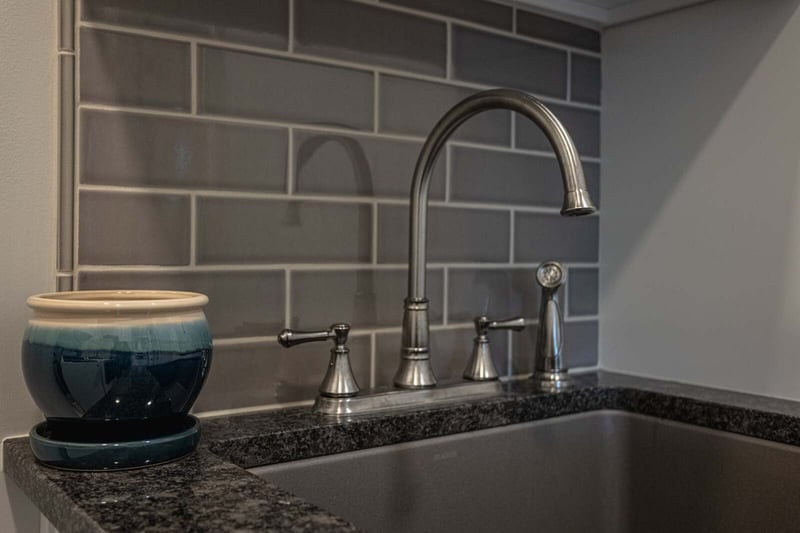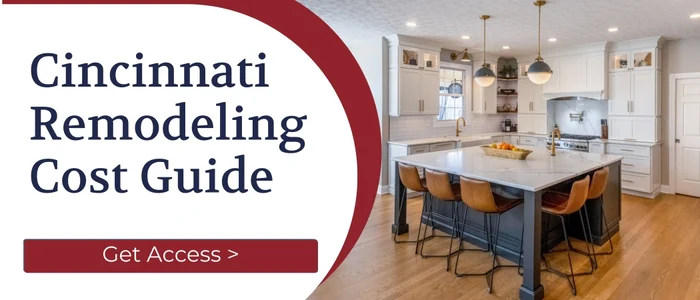How to Make Your Home More Energy Efficient
More than saving money, true energy efficiency is about creating a more comfortable, sustainable home for you and your family. When upgrading your home with a remodel, you likely have a unique opportunity to address energy leaks and outdated systems.
From advanced technology to smart design choices, Legacy Builders Group of Cincinnati is here to walk you through actionable strategies to make your home greener, cozier, and more cost-effective.

Install Low-Flow Faucets and Fixtures
One of the simplest ways to conserve resources and reduce energy costs is to install low-flow faucets and fixtures. What is a low-flow faucet, and how does it help? These fixtures use significantly less water than traditional models.

Update Your Lighting
Lighting is a key contributor to energy consumption. Transitioning to LED bulbs or motion sensor lights can drastically cut costs. For instance, LEDs consume up to 75% less energy and last significantly longer than traditional incandescent bulbs. And just how much energy do motion sensor lights save? By ensuring lights are only on when needed, they can save 30-50% on lighting energy use.
/Legacy%20Builders%20kitchen%20renovation%20featuring%20a%20large%20island%20and%20task%20lights%20in%20beverage%20station.jpg?width=800&height=534&name=Legacy%20Builders%20kitchen%20renovation%20featuring%20a%20large%20island%20and%20task%20lights%20in%20beverage%20station.jpg)
Opt for Energy-Smart Appliances
Upgrading to Energy Star-rated appliances is a great option when considering ways to make your house more energy efficient. But are Energy Star appliances worth it? Absolutely. These appliances are designed to consume less electricity and water without sacrificing performance. For example, an Energy Star-certified refrigerator can save up to 15% more energy than standard models, while a dishwasher can use 5,000 fewer gallons of water annually.
Wondering what your remodel might cost? Check out our cost guide here.

Use Gas or Electric: Choosing the Right Energy Source
Deciding between gas and electric systems is an important decision for an energy-efficient home. While both have pros and cons, the best choice often depends on your home's needs, environmental goals, and local utility rates.
| Feature | Natural Gas | Electricity |
|---|---|---|
| Cost Efficiency | Typically cheaper per unit of energy | Higher costs, but can be offset by solar panels |
| Energy Source | Fossil fuel, emits fewer greenhouse gases | Can be renewable (e.g., solar, wind, hydro) |
| Performance for Heating | Provides fast, reliable heat | May take longer to heat spaces or water |
| Cooking Benefits | Precise temperature control; preferred by chefs | Consistent heat; safer without open flame |
| Installation Cost | Often higher due to gas line requirements | Lower initial costs, especially in all-electric homes |
| Environmental Impact | Lower emissions than oil, but still a fossil fuel | Clean energy option if powered by renewables |
| Maintenance Requirements | Gas systems need regular safety checks | Typically lower maintenance requirements |
| Safety Considerations | Potential for gas leaks; requires proper ventilation | No risk of carbon monoxide; safer in enclosed spaces |
Upgrade Insulation
One of the most effective energy-efficient home upgrades is improving your insulation. How does insulation help conserve energy? By reducing heat transfer, insulation helps maintain your home's temperature, reducing the strain on your HVAC system. Key areas to target include attics, walls, and basements. Modern insulation materials, like spray foam or blown-in cellulose, offer superior performance compared to traditional fiberglass. For older homes in Ohio, upgrading insulation is a particularly impactful way to enhance energy efficiency while lowering utility costs.
Consider Radiant Floor Heating
Radiant floor heating is a luxurious and energy-efficient solution that provides consistent warmth by heating the floors rather than the air. Ideal for entire homes or targeted areas like primary suites and bathrooms, it adds comfort and eliminates cold spots. While often perceived as costly, installing it during a remodel when floors are already exposed for a remodel makes it surprisingly affordable.
/Main%20floor%20bathroom%20remodel%20in%20White%20Oak%2c%20OH%20with%20water%20closet%20layout-1.jpg?width=800&height=533&name=Main%20floor%20bathroom%20remodel%20in%20White%20Oak%2c%20OH%20with%20water%20closet%20layout-1.jpg)
Use Smart Tech Like Programmable Thermostats
Smart technology, such as programmable thermostats, is a game-changer in managing home energy use. These devices allow you to schedule temperature changes throughout the day, ensuring you're not heating or cooling an empty home. Many models also learn your preferences and optimize settings for maximum efficiency. Integrating smart thermostats with your HVAC system saves up to 10-12% on heating and cooling bills annually. This upgrade is a small investment with significant returns for energy efficiency.
Select Double or Triple Pane Windows
Windows are often a major source of energy loss in homes. Installing double or triple-pane windows can significantly improve your home's thermal performance. But are triple-pane windows worth it? While more expensive up front, they offer superior insulation, reducing heat loss in winter and heat gain in summer. For a balanced approach, consider high-quality double-pane options with low-emissivity coatings. Both options can enhance comfort, reduce energy bills, and qualify for energy-efficiency tax incentives.

Landscape for Energy Efficiency
Did you know your yard can contribute to your home’s energy efficiency? Strategic landscaping can reduce cooling and heating costs by creating natural barriers against the elements.
- Plant Trees for Shade: Deciduous trees placed on the south and west sides of your home can reduce cooling costs in summer while allowing sunlight to warm your home in winter.
- Use Windbreaks: Evergreen trees or shrubs planted along the north and west sides of your property can block cold winter winds, reducing heating needs.
- Incorporate Ground Cover: Low-maintenance ground cover reduces soil erosion and minimizes heat absorption, keeping your home cooler.
/Three%20chairs%20around%20fire%20pit%20in%20Evendale%2c%20OH%20outdoor%20living%20space%20by%20Legacy%20Builders.jpg?width=800&height=534&name=Three%20chairs%20around%20fire%20pit%20in%20Evendale%2c%20OH%20outdoor%20living%20space%20by%20Legacy%20Builders.jpg)
Upgrade HVAC Systems
Older HVAC systems are among the top contributors to high energy bills. Replacing your outdated system with a modern, energy-efficient model can drastically improve your home’s energy performance. Features like variable-speed motors and advanced air filtration reduce energy consumption and improve indoor air quality.
Incorporate Solar Panels or Renewable Energy
Integrating solar panels or other renewable energy sources is one of the most impactful energy-efficient home upgrades. While the upfront cost can be significant, Ohio offers energy efficiency programs and tax credits to offset installation expenses. Solar panels can generate clean, sustainable energy, significantly reducing your reliance on traditional utilities. For smaller-scale projects, consider solar water heaters or wind turbines, which are equally effective in cutting energy costs and supporting a greener home.
Choose Sustainable Materials
Using sustainable building materials in your home renovation is an excellent way to enhance energy efficiency while reducing your environmental footprint. Here are some fantastic examples of eco-friendly options to consider.
- Bamboo Flooring: Fast-growing and renewable, bamboo is a durable alternative to hardwood, offering a sleek, modern look that's more sustainable than traditional options.
- Reclaimed Wood and Metal: Reclaimed wood, sourced from old barns, factories, or other structures, adds rustic charm. Steel, aluminum, and copper can be repurposed for roofing, countertops, and structural elements.
- Cork: This renewable, recyclable material is harvested from the bark of cork oak trees. Ideal for flooring or underlayment, cork offers insulation and soundproofing benefits.
- Low-VOC Paints and Finishes: Reduce indoor air pollution with paints, stains, and finishes emitting less volatile organic compounds (VOCs).
- Recycled Glass Tiles: Vibrant, post-consumer glass tiles are perfect for backsplashes or bathroom walls.

Install a Tankless Water Heater
A tankless water heater is an efficient upgrade that heats water on demand, eliminating the energy waste associated with traditional storage tanks. These systems provide endless hot water while using less energy, making them ideal for eco-conscious households. Compact, long-lasting, tankless water heaters free up space and reduce utility costs.
Design Build Remodels in Cincinnati
Ready to make your home more energy-efficient and comfortable? Legacy Builders Group loves transforming tired spaces with sustainable, high-quality renovations tailored to your needs. Contact us today to turn your home into an energy-saving masterpiece!


